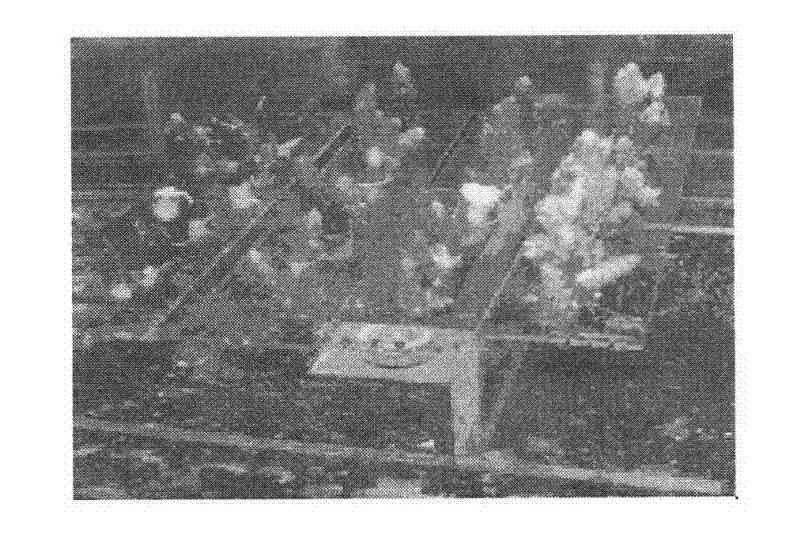Method for cultivating new coral samples in indoor coral culture for scientific researches
A coral and sample technology, applied in animal husbandry, etc., can solve problems such as difficult to popularize and apply, hard to find, and unable to use blocky Porites, and achieve low cost and effective collection
- Summary
- Abstract
- Description
- Claims
- Application Information
AI Technical Summary
Problems solved by technology
Method used
Image
Examples
Embodiment 1
[0033] Embodiment 1 A kind of cultivation method of new growth coral sample in the indoor coral culture of scientific research (see figure 1 ), including the following steps:
[0034](1) Sampling:
[0035] Cut the healthy branched corals into several branches, drill several holes on the polyethylene plate with a thickness of 2-5mm, and insert the coral branches into the drill holes; the diameter of the drilled holes is the same as the diameter of the coral branches match (see image 3 ).
[0036] (2) Cultivation: put the coral samples of step (1) gained into culture systems (provided by the Qinghai Institute of Salt Lakes, Chinese Academy of Sciences) with different salinities or different pH values or different temperatures for cultivation; through 10 to 20 days, There will be a coral skeleton deposition ring (brown part) around the drilling hole of the polyethylene board, indicating that the coral begins to grow on the polyethylene board and continue to grow, the coral...
Embodiment 2
[0039] Embodiment 2 A kind of cultivation method of new growth coral sample in the indoor coral culture of scientific research (see figure 2 ), including the following steps:
[0040] (1) Sampling:
[0041] Drill several holes in Porites massive and insert several pipe rods into the holes; where the diameter of the pipe rods matches the diameter of the drill holes (see Figure 4 ).
[0042] (2) Cultivation: put the coral samples of step (1) gained into culture systems (provided by the Qinghai Institute of Salt Lakes, Chinese Academy of Sciences) with different salinities or different pH values or different temperatures for cultivation; through 10 to 20 days, There will be a coral skeleton deposition circle (brown part) on the pipe rod, indicating that the coral begins to grow on the pipe rod. Continue to culture, the coral skeleton deposition ring will continue to expand upwards, and stop when the total amount of coral skeleton deposition is 200-1000mg cultivate.
[004...
Embodiment 3
[0045] Embodiment 3 A kind of cultivation method (see figure 2 ), including the following steps:
[0046] (1) Sampling:
[0047] Make several grooves on the block Porites, and insert several sheets into the grooves; the thickness of the sheets matches the width of the grooves (see Figure 5 ).
[0048] (2) Cultivation: put the coral samples of step (1) gained into culture systems (provided by the Qinghai Institute of Salt Lakes, Chinese Academy of Sciences) with different salinities or different pH values or different temperatures for cultivation; through 10 to 20 days, There will be a coral skeleton deposition ring (brown part) on the sheet, indicating that the coral begins to grow on the sheet. Continue to culture, and the coral skeleton deposition ring will continue to expand upwards. When the total amount of coral skeleton deposition is 200-1000mg Stop breeding.
[0049] (3) Collection of new growth coral samples:
[0050] Take out the bulk Porites body, take the s...
PUM
 Login to View More
Login to View More Abstract
Description
Claims
Application Information
 Login to View More
Login to View More - R&D
- Intellectual Property
- Life Sciences
- Materials
- Tech Scout
- Unparalleled Data Quality
- Higher Quality Content
- 60% Fewer Hallucinations
Browse by: Latest US Patents, China's latest patents, Technical Efficacy Thesaurus, Application Domain, Technology Topic, Popular Technical Reports.
© 2025 PatSnap. All rights reserved.Legal|Privacy policy|Modern Slavery Act Transparency Statement|Sitemap|About US| Contact US: help@patsnap.com



